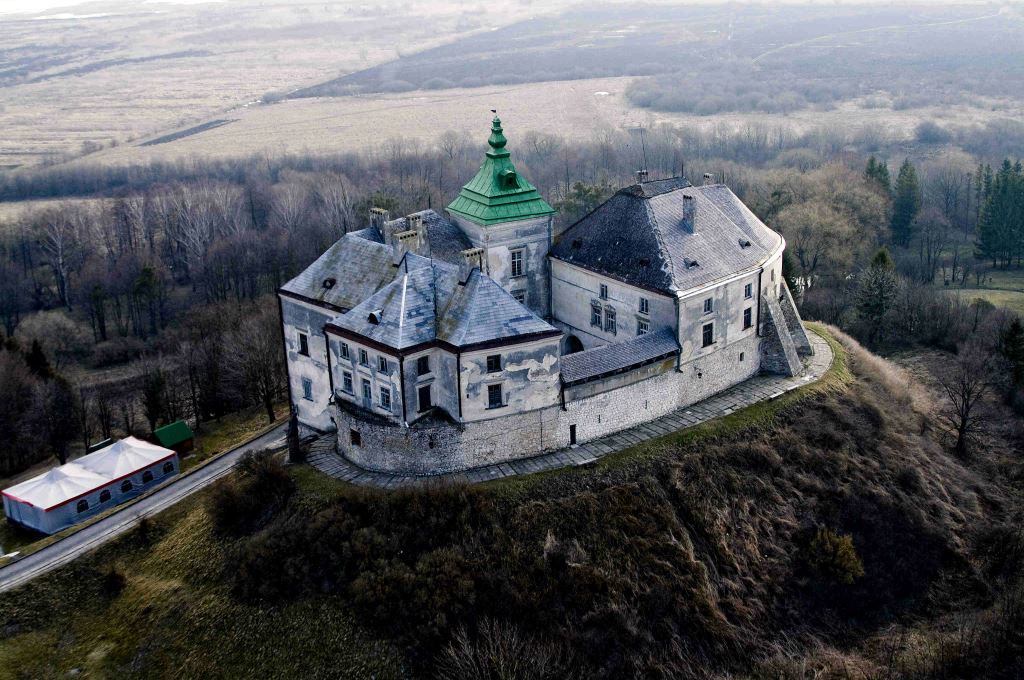Olesko Castle

Photo: studway.com.ua
Located about seventy-five kilometers from Lviv, Olesko Castle, oval in its shape, stands tall on top of a hill, about fifty meters in height. The castle was, at different times, owned by Poland, Lithuania, and Hungary. In the 15th century, the castle was changed from being a defense point, to simply a getaway for aristocracy. The castle is perhaps most famous for being the birthplace of the Polish king Jan III Sobieski, the hero of the Battle of Vienna.
Today it is a museum, displaying the collections of antique furnishings and art dating from the 16th-17th centuries. It also features sculptures, paintings, still lives, applied arts, tapestries, period weapons, and objects used in everyday life at the time. Its collection is regarded as one of the richest treasury of Polish art outside borders of Poland.
Pidhoretsky castle

Photo: razom.media
Pidhoretsky Castle is a residential castle-fortress located in the village of Pidhirtsi, located eighty kilometers east of Lviv. It was constructed by Guillaume Le Vasseur de Beauplan between 1635–1640 by order of the Polish-Lithuanian Commonwealth's Grand Crown Hetman Stanisław Koniecpolski. Constructed on the place of the older fortress, the castle has been then part of the Kingdom of Poland, and it is regarded as the most valuable of palace-garden complexes in the eastern borderlands of the former Polish-Lithuanian Commonwealth.
Unfortunately, now Pidhoretsky castle is closed for visitors, however tourists still include it in their tours as this castle’s magnificent beauty makes it worth exploring if only from the outside.
Read: Alexandria Park near Kiev
Zolochiv Castle

Photo: astrawest.com.ua
Zolochiv Castle was a residence of the Sobieski noble family on a hill at the confluence of two small rivers in the south-eastern part of Zolochiv, Galicia (now a part of Ukraine's Lviv Oblast). Since 1985 the complex has been supervised by the Lviv Art Gallery and under restoration. Recently it began to open its grounds for visitors. Exhibits include more than 25 European coats of arms, dinosaur bone chandeliers, and a replica of a typical royal crown from the 13th century, that could be similar to that of Daniel of Galicia.
Svirzh Castle

Photo: openmind.com.ua
Svirzh Castle is a fortified aristocratic residence in Svirzh, Ukraine. It was originally built by the Świrzski noble family in the 15th century. A small church dating from 1546 is located inside the castle. The castle stood in ruins for many years. It was restored in 1907, only to be devastated by fire in 1914. Rebuilding and restoration have occurred on several occasions since.
Stare Selo Castle

Photo: photomandry.com.ua
Stare Selo (Old village) Castle is located in a village of the same name. The existing fortress, almost triangular in shape, with 15-metre high walls and a ceremonial gate on the south side, was commissioned by Prince Władysław Dominik Zasławski, one of the last members of the Ostrogski family. After Prince Zaslawski died in Stare Selo in 1656, the fortress gradually fell into disrepair, although it successfully withstood a siege by the Turks in 1674. Stare Selo Castle now waits to be restored and brought back to its former glory.
Read: Catacombs in Odessa
Most popular tourist route, the so called "Golden Horseshoe of Lviv region», was created specially to promote the castle legacy of Galicia region.This route consists of five major landmarks: Olesko, Pidhirtsi, and some Zolochiv Castles. The best option is to travel by car or by bus, as all of 5 castles are located by the highway and you can examine all of them within 1 day. Today many travel companies offer «Castles of Western Ukraine» tour as castles are among most popular local attractions. You'll have a great chance to see castles as well as try food and wine tastings in the medieval restaurants.







